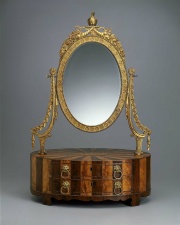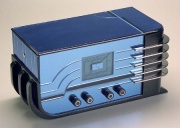Difference between revisions of "Mirror"
(username removed) |
(username removed) |
||
| Line 2: | Line 2: | ||
== Description == | == Description == | ||
| − | A smooth, polished surface capable of reflecting an image of an object placed in front of it. Mirrors were originally made from highly polished [http://cameo.mfa.org/materials/fullrecord.asp?name=metal metal]. Crude [http://cameo.mfa.org/materials/fullrecord.asp?name=glass glass] mirrors were first made in Venice in 1278. Glass mirrors with a metallized backing were first constructed in Venice in the 16th century using an [http://cameo.mfa.org/materials/fullrecord.asp?name=amalgam amalgam] of [http://cameo.mfa.org/materials/fullrecord.asp?name=tin | + | A smooth, polished surface capable of reflecting an image of an object placed in front of it. Mirrors were originally made from highly polished [http://cameo.mfa.org/materials/fullrecord.asp?name=metal metal]. Crude [http://cameo.mfa.org/materials/fullrecord.asp?name=glass glass] mirrors were first made in Venice in 1278. Glass mirrors with a metallized backing were first constructed in Venice in the 16th century using an [http://cameo.mfa.org/materials/fullrecord.asp?name=amalgam amalgam] of [http://cameo.mfa.org/materials/fullrecord.asp?name=tin%20leaf tinfoil] and [http://cameo.mfa.org/materials/fullrecord.asp?name=mercury mercury]. In 1836, a German chemist, J. von Liebig, developed a method to coat the glass with a silver salt then reduce it to metallic [http://cameo.mfa.org/materials/fullrecord.asp?name=silver silver]. The silver gave a brighter image but was more expensive. The back of the silver mirrors were usually protected with several layers of [http://cameo.mfa.org/materials/fullrecord.asp?name=paint paint]. Now large mirrors are usually backed with vapor deposited [http://cameo.mfa.org/materials/fullrecord.asp?name=aluminum aluminum]. Small specialty mirrors are vapor coated with silver. |
[[File:Image3_802396.jpg|thumb|'''MFA Acc. #:''' 1997.76]] | [[File:Image3_802396.jpg|thumb|'''MFA Acc. #:''' 1997.76]] | ||
Revision as of 06:37, 24 July 2013
Description
A smooth, polished surface capable of reflecting an image of an object placed in front of it. Mirrors were originally made from highly polished metal. Crude glass mirrors were first made in Venice in 1278. Glass mirrors with a metallized backing were first constructed in Venice in the 16th century using an amalgam of tinfoil and mercury. In 1836, a German chemist, J. von Liebig, developed a method to coat the glass with a silver salt then reduce it to metallic silver. The silver gave a brighter image but was more expensive. The back of the silver mirrors were usually protected with several layers of paint. Now large mirrors are usually backed with vapor deposited aluminum. Small specialty mirrors are vapor coated with silver.
Synonyms and Related Terms
looking glass; espejo (Esp.); miroir (Fr.); spiegel (Ned.); espelho (Port.)
Additional Information
P.Hadsund "The Tin-Mercury Mirror: Its Manufacturing Technique and Deterioration Processes" Studies in Conservation, 38:3-16, 1993.

